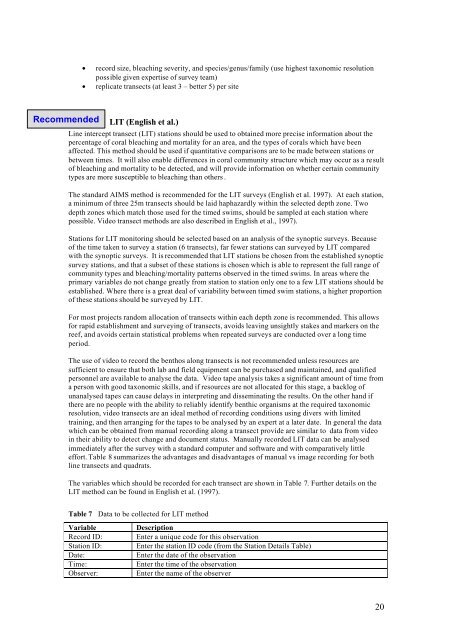Oliver et al (2004) Monitoring bleaching
Oliver et al (2004) Monitoring bleaching.pdf
Oliver et al (2004) Monitoring bleaching.pdf
Create successful ePaper yourself
Turn your PDF publications into a flip-book with our unique Google optimized e-Paper software.
• record size, <strong>bleaching</strong> severity, and species/genus/family (use highest taxonomic resolution<br />
possible given expertise of survey team)<br />
• replicate transects (at least 3 – b<strong>et</strong>ter 5) per site<br />
Recommended<br />
LIT (English <strong>et</strong> <strong>al</strong>.)<br />
Line intercept transect (LIT) stations should be used to obtained more precise information about the<br />
percentage of cor<strong>al</strong> <strong>bleaching</strong> and mort<strong>al</strong>ity for an area, and the types of cor<strong>al</strong>s which have been<br />
affected. This m<strong>et</strong>hod should be used if quantitative comparisons are to be made b<strong>et</strong>ween stations or<br />
b<strong>et</strong>ween times. It will <strong>al</strong>so enable differences in cor<strong>al</strong> community structure which may occur as a result<br />
of <strong>bleaching</strong> and mort<strong>al</strong>ity to be d<strong>et</strong>ected, and will provide information on wh<strong>et</strong>her certain community<br />
types are more susceptible to <strong>bleaching</strong> than others .<br />
The standard AIMS m<strong>et</strong>hod is recommended for the LIT surveys (English <strong>et</strong> <strong>al</strong>. 1997). At each station,<br />
a minimum of three 25m transects should be laid haphazardly within the selected depth zone. Two<br />
depth zones which match those used for the timed swims, should be sampled at each station where<br />
possible. Video transect m<strong>et</strong>hods are <strong>al</strong>so described in English <strong>et</strong> <strong>al</strong>., 1997).<br />
Stations for LIT monitoring should be selected based on an an<strong>al</strong>ysis of the synoptic surveys. Because<br />
of the time taken to survey a station (6 transects), far fewer stations can surveyed by LIT compared<br />
with the synoptic surveys. It is recommended that LIT stations be chosen from the established synoptic<br />
survey stations, and that a subs<strong>et</strong> of these stations is chosen which is able to represent the full range of<br />
community types and <strong>bleaching</strong>/mort<strong>al</strong>ity patterns observed in the timed swims. In areas where the<br />
primary variables do not change greatly from station to station only one to a few LIT stations should be<br />
established. Where there is a great de<strong>al</strong> of variability b<strong>et</strong>ween timed swim stations, a higher proportion<br />
of these stations should be surveyed by LIT.<br />
For most projects random <strong>al</strong>location of transects within each depth zone is recommended. This <strong>al</strong>lows<br />
for rapid establishment and surveying of transects, avoids leaving unsightly stakes and markers on the<br />
reef, and avoids certain statistic<strong>al</strong> problems when repeated surveys are conducted over a long time<br />
period.<br />
The use of video to record the benthos <strong>al</strong>ong transects is not recommended unless resources are<br />
sufficient to ensure that both lab and field equipment can be purchased and maintained, and qu<strong>al</strong>ified<br />
personnel are available to an<strong>al</strong>yse the data. Video tape an<strong>al</strong>ysis takes a significant amount of time from<br />
a person with good taxonomic skills, and if resources are not <strong>al</strong>located for this stage, a backlog of<br />
unan<strong>al</strong>ysed tapes can cause delays in interpr<strong>et</strong>ing and disseminating the results. On the other hand if<br />
there are no people with the ability to reliably identify benthic organisms at the required taxonomic<br />
resolution, video transects are an ide<strong>al</strong> m<strong>et</strong>hod of recording conditions using divers with limited<br />
training, and then arranging for the tapes to be an<strong>al</strong>ysed by an expert at a later date. In gener<strong>al</strong> the data<br />
which can be obtained from manu<strong>al</strong> recording <strong>al</strong>ong a transect provide are similar to data from video<br />
in their ability to d<strong>et</strong>ect change and document status. Manu<strong>al</strong>ly recorded LIT data can be an<strong>al</strong>ysed<br />
immediately after the survey with a standard computer and software and with comparatively little<br />
effort. Table 8 summarizes the advantages and disadvantages of manu<strong>al</strong> vs image recording for both<br />
line transects and quadrats.<br />
The variables which should be recorded for each transect are shown in Table 7. Further d<strong>et</strong>ails on the<br />
LIT m<strong>et</strong>hod can be found in English <strong>et</strong> <strong>al</strong>. (1997).<br />
Table 7 Data to be collected for LIT m<strong>et</strong>hod<br />
Variable<br />
Record ID:<br />
Station ID:<br />
Date:<br />
Time:<br />
Observer:<br />
Description<br />
Enter a unique code for this observation<br />
Enter the station ID code (from the Station D<strong>et</strong>ails Table)<br />
Enter the date of the observation<br />
Enter the time of the observation<br />
Enter the name of the observer<br />
20


















